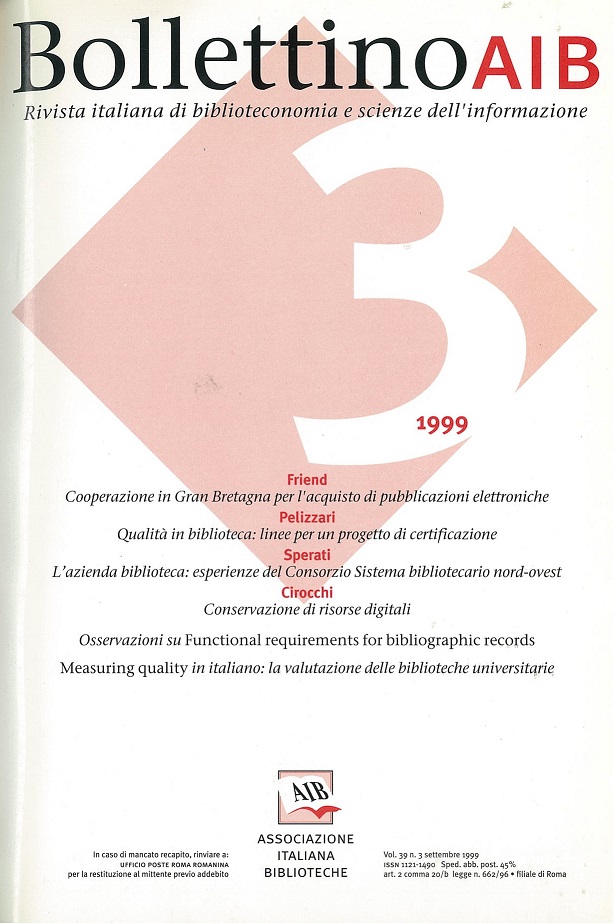Quality in the library: guidelines for a certification project
Main Article Content
Abstract
In recent years, the importance ascribed to quality assessment has been progressively increasing, extending from production environments to services and the public administration. The concept of quality has also undergone an evolution which has made customer satisfaction or, in the case of services, that of the consumer/user its principal assessment parameter. The concept of quality has passed from that conceived and measured as the deviation from well-defined technical specifications (in the case of products) or on the basis of bureaucratic/procedural requisites (in the case of services) to one measured according to a product/service's capability to satisfy the user's needs.
Increasingly, this revised approach to the problem of quality has placed centre-stage regulatory activity on the one hand and certification of conformity to it on the other.
The aim of a university library, whatever its configuration, is the provision of services to its own differentiated typologies of institutional users. Hence university libraries also have to analyse the services they offer and the new regulations for universities introduce an important change of perspective as regards the ends of planning: qualification, and no longer quantitative growth is now the objective. Planning is redefined in terms of the objectives deemed strategic for the innovation of the university system within which quality assessment is the base element.
The ISO regulations are the indispensable reference if one is to progress from improvement of services to the institution of a "quality system" and, to end, its certification. The ISO 9000 regulations aim to lay down at world level the applicable rules regarding the university "quality system", whose complexity is inversely proportional to that of the company and product/service offered.
The greatest risk of "regulated" quality is its responsiveness to the situation of the moment, namely the danger that the supplier of the services - the library - will tend to guarantee only what is required by the regulations. The internal checks, "passing the exam" imply a periodic concentration on this aspect, subtracting energies from improvement; the effort continually required to comply with specific requisites can end up by again engendering a bureaucratic and braking stance within the organisation. Its greatest strength, on the other hand, is undoubtedly the attempt to safeguard the client/user, anchoring the services to said's explicit and implicit needs.
To eliminate the risk implied by regulation-defined quality, it may be appropriate, continuing in the creation of the "quality system" on the basis of ISO 9000, to include in the process some of the most fertile contributions introduced by the conceptual model and operational practice of total quality management which envisages the extension of quality control and assurance to all the organisation of the activities and responsibilities, making not the product or service the priority, but rather the process which generates them.
Shifting the focus from the product or service to the organisation and process eliminates the profit/non profit variable, which means the model can be transferred from the corporate ambit, in which it emerged, to service structures, including libraries, in which the emphasis should be on the human resources, their capacity to creatively contribute to the functioning of the service.
In addition to being the basic condition for its certification, measurement of the library's performance is a central aspect of the quality system's functioning, on the principle that only that which can be measured and assessed can be improved.
Constructing a quality system which conforms to the UNI EN ISO 9002 regulations, as specified in UNI EN ISO 9004/2, means that all the functions of the library institution have to develop a consistent commitment whose condition and premise is the determinant participation of management. The first function of the management is to draw up a declaration of intents, subsequently defining the objectives the implementation of the quality system aims to pursue and identifying the levels of precedence and importance.
The definition of the objectives the quality system should pursue is the act of foundation itself of the system which will be followed by: appointment of the person responsible for the project and involvement of the other functions; involvement of all the functions involved in the realisation of the quality system.
The project's preparatory phase (which we can hypothesise lasts a few months) will conclude with the management formalising and diffusing the quality plan in the most appropriate manner, while the second phase envisages: external study, internal study, commencement of the improvement projects: drafting of the quality documentation: check, review and updating of the system.
Certification is the last step of the improvement project the library implements to satisfy the user's needs and entails choosing the certificating body or bodies empowered for such role. This certifying body will analyse all the documentation, which should satisfy the conformity requirements of the UNI EN ISO 9002 regulations. The certifying body will then issue a report (the so-called "audit") which assesses the implementation of the quality system. Any shortcomings or "non conformities" found will be communicated to the library which will be requested to plan or undertake - normally by a deadline - the corrective actions to eliminate them.
Article Details

This work is licensed under a Creative Commons Attribution-ShareAlike 4.0 International License.
